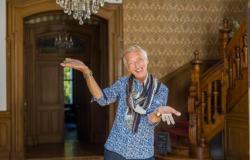Scene from the life of a blended family. Ten-year-old Eva Roozendaal goes to school camp. Her father, mother and stepmother are in the school yard to wave her goodbye. When she is on the bus, she first looks for her father. She waves at him and gives him kisses. Then her mother, they laugh and wave at each other. Also those cheerful kisses.
The stepmother is standing a little further away. As Eva looks again at her father, and then back at her mother, the stepmother waves exuberantly while an unpleasant feeling spreads in her stomach. When the bus pulls up, Eva also looks at her. Just for a moment.
Eight years later, Eva (18) is sitting at their kitchen table in Amsterdam-Noord with her stepmother Jasperina Roozendaal (52) and sister Anne Roozendaal (21). “Sweet, but still sad,” Jasperina says cheerfully about this memory. Eva and Anne laugh, but they look shocked.
Jasperina: “Yes! You’re not the original after all. I stood there playing a role by waving and smiling, all the while thinking: She’s probably not going to look at me. I also find such emotions childish, because it is not about me at such a moment. But I do feel it. It felt lonely, because of course I couldn’t say to anyone: ‘Well, that’s strange, she’s not waving at me at all.’ As a stepmother you always have to pull yourself together.”
More than half a million Dutch children grow up in a blended family. This means that 16 percent of all minors live with at least one stepparent, stepbrother or sister or half-sibling, according to CBS figures from 2020. Eva was two and Anne was five when their parents separated. And Jasperina, a copywriter by profession, was 36 when she became the new partner of their father Martin and the stepmother of his daughters. She had no children of her own yet. About those two girls she thought: bring it on, we’ll see.
She has written a book about her stepmotherhood, Up to your ears, which came out last week. Subtitle: A cheerful look at stepmothers. She mainly wants to show the other side. Not that of the evil stepmother from the fairy tales, not with the emphasis on the problems that often exist in a blended family. “I myself have missed a positive role model. I ended up with books with titles like Step managementbooks in which coaching programs were recommended.”
Compare it to when you are pregnant, she says. Then you don’t want to hear horror stories all the time about other people’s deliveries. “It can also go well. With my book I want to show: just go ahead and do it, it’s great fun, you’ll figure it out with your common sense and sense of humor.”
The bad image of the stepmother is not only because of Snow White and Cinderella. The figures from Statistics Netherlands are grim: of adults who grew up with stepparents, 44 percent consider the stepfather as a father. But only 17 percent see the stepmother as a mother.
Jasperina: “That of course has a broader context. Most children continue to live with their mothers, especially when the adults surveyed were young. They therefore saw the stepmother less often than the stepfather, which meant there was less time to get used to each other.” And in doing so, she says, stepmothers are placed next to the bar of holy mothers.
Children are not the most grateful creatures, are they?Jasperina Roozendaal
University lecturer Johannes Mol also saw this in the research he did for his book Stepfather families, to which Jasperina Roozendaal regularly refers in her book. Jasperina: “Stepmothers take on more care responsibilities than stepfathers, work harder to keep things running, but they are much less likely to do it well. Children are not the most grateful beings, they don’t say: how cool that you do all those things for us. And especially in the beginning you have to do that without their unconditional love. So you cook, wash and care, you have sleepless nights because of all your insecurities, you suddenly live in peace, cleanliness and regularity while you actually want to be in the pub and then your stepchild still says: yes, but you are not my mother. ”
Did you also receive that comment?
Jasperina: “Anne and Eva are way too sweet for that.”
Eva: “I don’t think I could say it either, because you have always taken care of me. I have no memories of the time when you were not there.”
The difference between the biological mother and the stepmother is an important theme in your book. Why does that concern you so much?
Jasperina: “I would like to escape it, but I cannot avoid it. Because even though I am also their mother, I would never say that if someone asks me what my relationship is with Anne and Eva. At most: these are my daughters from another mother.”
Yet you keep calling them ‘my daughters’.
Jasperina: “Yes, at first I kept writing about my stepdaughters. My editor said, it’s funny that you hate the word “step” so much and yet use it all the time. I felt like I couldn’t bring myself to call them my daughters. But she told me to let that go.”
Anne: “I never understood why the word stepmother has such a negative connotation. I don’t feel that charge when I say it, but bystanders do react that way.”
Eva: “When I tell them that I have stepparents, people always ask me a question to which they expect a negative answer. Like: oh, and do you have a good relationship with everyone?”
Anne: “Or: which house would you rather be in? I think that’s a stupid and strange question, and I often answer it with: which of your parents do you like better? Because you ask something so personal, and then you also count on a negative answer.”
Jasperina, in the book you say that Eva, when she was little, said she wanted to call you mommy too, but her mother told her she only had one mommy. How did you like that?
Eva: “Really?”
Jasperina: “Yes. This was the early period, years later their mother sometimes said to me that of course I am also their mother. There was no malicious intent behind it.”
It confused Eva.
Jasperina: “Yes, Eva, you were confused then. You made a mistake every time and wanted to just say mom. Even though you didn’t end up doing that, it remained Pina.”
Eva: “I really don’t remember that.”
Anne: “I knew that you didn’t understand the message. You also asked me why you couldn’t just call Pina mom. I then said that you should just do that, because they were adult emotions that you didn’t have to worry about as a child. Too bad for mom if she didn’t like that, but not your problem.”
It takes years for a blended family to get used to each other, even in the best of cases. A painful memory of Jasperina is the musical chairs at the start of every meal. “Then Anne said: I want to sit next to Dad. And then Eva said: me too. Martin usually sat next to me to show that I was really okay.”
When crossing a street, the girls only wanted to hold their father’s hand. Jasperina: “When they came up the stairs on changeover day, I had a pain in my stomach from the tension. I saw how Martin was on cloud nine that his daughters were back, while I thought: they are five and two and I am afraid for them.” It was, she says, a kind of nursery and toddler jury. “You can still be so in love, they also had to accept me. I tried extra hard, never thought: I’m in a bad mood today and I’m just going to sit on the couch feeling grumpy.”
Also difficult: the outside world. Their opinions, expressed or not, and their eyes, judging or not. At a birthday party at her parents-in-law’s house, Jasperina said to Eva: we are leaving, so you have to put on your shoes now. “But Eva sat down in the middle of that room full of people. I had learned from Martin that you have to be very clear with children, so I said: let’s go, put on your shoes now. And then she started crying really hard.”
Anne and Eva laugh loudly.
Jasperina: “I would have preferred to cry along. What would all those people think? What kind of woman has Martin brought into his home? It exploded in my head. And I thought: see, I’m not doing this right, I can’t do this. I was hard on myself. Everything had to be right right away and there are a lot of people you have to take into account. The bond with the children is more fragile. As a mother you have much more control. I still sometimes feel like I could still screw up.”
It became easier when she became a mother herself, of Job. Jasperina: “From that moment on we really became a family. Everyone could surrender to that little brother without any conditions. And a mother hatch opened for me, I understood Martin and his ex-wife better. In the beginning I sometimes said: everyone should do co-parenting, enjoy half a week off. But when I had Job, I understood what it must be like to entrust the care of your child to someone else.”
In the book she writes that she is sometimes asked whether the love for the girls is as unconditional as that for her son. She finds that, she writes, an annoying question. “As if you can measure love.” But if she has to compare, then the love for her son is more obvious. She writes: “I never thought about that. It was just there from the moment he was born. The love for my girls had to grow.”
You also write that you once spent an hour thinking about which child you would save first if the house caught fire – yours or his.
Jasperina: “Yes! I couldn’t figure it out. But that also says something about who I am, I think about everything. I really wanted to do well. I felt that responsibility. It’s the same way I felt so guilty at first because I didn’t love them right away.”
When did you start to feel that?
Jasperina: “I noticed that I started to miss them when they were with their mother. And that I started telling friends about them. A friend always asked about Job and I started thinking: why don’t you ask about Anne and Eva? At a certain point it is just there. Then I was no longer nervous when they came, but happy. After three weeks of holiday together, I felt bad when they went to their mother.”
To share
Email the editor
Tags: Jasperina Roozendaal wrote book stepmother great fun
-





